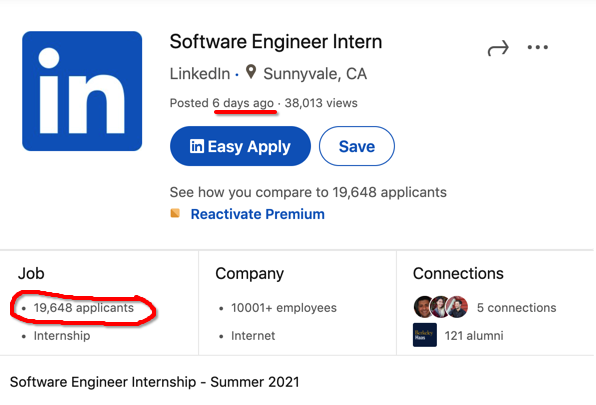Recently, much to my horror, I saw how many applicants there were for a software engineering internship position at LinkedIn. Here's a screenshot:
And a link if the posting is still up.
They had 19,648 applications for one position for an internship. That is absurd.
The Time and Cost of Processing 20K Applications
Let's do some maths quickly, because while I am convinced that this many applications is more of a burden than a value-add for anyone in recruitment or HR, I'll happily set my thoughts aside and take a logical approach here.
We shall assume that there is one recruiter for this position, therefore 1 person has to review 19,648 applications, resumes, or LinkedIn profiles.
If the recruiter takes 5 minutes per application, this translate to the following number of days:
19,648 x 5 minutes = 98,240 minutes
98,240 minutes / 60 minutes in an hour / 8 hours per day = 204.67 days
So if the recruiter works for 8 hours solid, uninterrupted for 205 days (which is over 6 months by the way), then they will have finished processing the applications. This is step 1, we haven't even moved on to phone interviews yet.
We assume 5 minutes per application to account for the time cost of context switching, reasonable bathroom breaks and other breaks, and going back to applications that are in the "yes" pile to compare them with incoming or new applications and making a decision accordingly.
What is the cost of these 205 days? Well, we're paying the recruiter a salary. Since LinkedIn is based in the Bay Area, let's take an average technical recruiter's salary in the Bay Area. (Built in SF say $120K, salary.com says $93K, and LinkedIn says $95K) So I will assume $95,000 annual salary to be simple.
$95,000 / 365 days = $260.27 per day
$260.27 * 205 days = $53,356.14
So to a basic calculation tells us that it would cost LinkedIn at least $53K to process 20K applications for their internship position.
How many phone interviews will they do. For 1 position, let's say that they do phone interviews for 20 candidates, which is .1% of the applications received by the way. If it takes a day to contact the candidates, 2 days to do the interviews at 10 interviews per day:
1 day + 2 days = 3 days
3 days * $260.27 = $780.81
From there, we assume that 3 candidates makes it to the final round. Let's assume 1 day to set up the interviews and prepare each candidate for the technical interviews, and 1 day per candidate for the technical interviews, including all of the follow up both with the candidate and internally.
1 day + 3 days = 4 days
4 days * $260.27 = $1041.08
I've actually no idea whether this is LinkedIn's hiring process - a phone interview then a technical interview, so don't rely on this post for that kind of information. I'm just doing some simple maths here.
I will assume that a candidate is chosen, an offer is made, and that they accept. (Imagine if they refused being the 1 out of 20K applicants!!)
To select 1 person from the 19,648 applicants, it would take 212 days, or just over 7 months, to process the applications, do a round of phone interviews, and do a round of technical interviews, costing $55,178.03 in recruiter salary.
That is an expensive intern.
LinkedIn Won't Take 7 Months to Hire an Intern. So How Do They Process 20K Applications? Hiring Software.
Obviously, LinkedIn will not take 7 months to hire an intern. I don't think they will pay additional recruiters to review each application individually, because it would still cost them $55K even if the time frames were shorter.
So, how are they going to process 20K applications? It's simple: they won't.
First of all, it is highly likely that they are using some kind of hiring software. Most recruiters use an ATS (Applicant Tracking System) which automatically filters applications based on various things including:
- resume format
- keywords in the resume
In short, if your resume is multi-column and you don't have the right keywords, you're automatically counted out. So if you have a nice-looking two-column resume, BAM! Goobye application.
Filters and If...Then... Statements
Another way for recruiters to quickly filter out candidates is by applying filters and using "if...then..." statements. For example, if an applicant has already graduated with a college degree, then reject the application. Such filters and automatic rejections can be configured based on the job requirements. In the case of this internship, they are looking for candidates who will return to a degree program after completion of the internship.
You can imagine that by applying a series of filters and if...then... statements, the recruiter can use software to narrow down the pool of candidates fairly quickly and easily without ever looking at the application.
Auto-reject 15K Applications: How to Process The Remaining 5K
Let's assume that through the software, the recruiter can reduce the number of applications by 75%. Given the economy, I imagine that most applications come from recent graduates who are finding it very difficult to get a job and who are applying to internships regardless of the stated requirements (which is entirely understandable).
With around 5K applications left to process, some more quick maths using our assumptions above would indicate that processing 5K applications at 5 minutes per application would take:
19,648 * (1 - 0.75) x 5 minutes = 24,560 minutes
24,560 minutes / 60 minutes in an hour / 8 hours per day = 51.67 days
Will a recruiter take 52 days to look at 5K applications for an internship position? Doubtful.
If they receive 1 email per application, that's 5,000 emails. It would be an effort and a half to process 5,000 applications in 52 days, but possible. However, recruiters aren't responsible for just one job posting, meaning that if they have 10 open jobs, they will most certainly have other applications flying in and thousands of other emails to which they must respond.
In light of that, it's safe to assume that they simply cannot look at 5K applications in 52 days.
Let's look at some maths the other way around. Assume that the recruiter has 1/3 of their day available to work on applications for the Internship position. They could spend up to 1 month reviewing applications before replying to candidates who are selected for the next round.
8 hours per day * 33% * 30 days in a month = 79.2 hours
The recruiter has 79.2 hours to consider applications for the position. At 5 minutes per application, that means they could look at:
79.2 hours x 60 minutes per hour / 5 minutes per application = 950 applications
That means that realistically, they look at 950 out of 19,648 applications, or 4.84% of applications received.
I imagine from there, they select 1 out of every 10 applications, send them the HackerRank exercise that they mentioned in the post, and then narrow down a shortlist of candidates for a phone interview.
How they select the 1 out of every ten, I have no idea.
Self-serving Algorithms: No One is Winning By Accepting 20K Applications
If you look at other software engineer internships on LinkedIn, there is not a single other post that has 19K applications. In fact, I could only find 1 other software internships that had over 2,000 applications and all the rest were under 2,000. A lot were around the 300-400 mark, with smaller or less well-known companies tending to have around 100.
So I have to ask the question, is LinkedIn using their own job platform to promote their own job postings at their company? Given the data, it is very difficult to argue no, unless somehow LinkedIn has become the most incredible company that everyone wants to work for.
Given that it is highly likely that LinkedIn is using their own platform to promote their own jobs, which I understand, I have to ask if this is helping them as a company. Honestly, I fail to see how receiving 20K applications for an internship helps the company. It could create a huge amount of work for recruiters, but we reasoned that in reality, most applications are simply not considered or looked at, meaning that applicants are a victim here.
It's difficult enough to get an entry-level job in software in California when the economy is going well. It's even more difficult when the economy is not going well. Knowing that job applications have an emotional part to them, I really think that LinkedIn should reconsider the likely self-promotion of their jobs in their algorithms for returning job posting results. I don't have proof; this is entirely a hunch, but the data has outliers so I start to ask questions. I mean 20K applications is ridiculous when other promoted jobs don't have even 10% of that.
I like LinkedIn, and I like their REACH program efforts, but today, I am not a fan of their platform and that they've accepted so many applications. Poor form, LinkedIn.
The Challenge of Today's Entry-Level Jobs and What We're Doing About It
Getting into an "entry-level" job as a software engineering, especially in California, Seattle, and some of the other major tech hubs worldwide can be difficult because the level demanded by hiring companies is high. Look at any job description for Software Engineer and you'll see that there's a long list of requirements and capabilities.
At Qwasar, we're convinced that most learners in CS degrees, those people eligible for the Internship such as that at LinkedIn, won't actually learn what is required to get into a Software Engineer job. Part of our mission as a company is to train our learners to Silicon Valley standards: that means that they have the capacities, skills, and experience required for SWE jobs, as well as the technical interview skills to actually get hired.
If the 20K applicants were all CS students, how will they get to the level required for software engineer jobs? Will they be able to answer yes to the following:
- Have you previously coded more than 10,000 lines in C, C++, or Java?
- Do you consistently write code to a coding norm?
- Have you designed and built an architecture and code base for a project that could withstand more than 50,000 users simultaneously?
- Have you translated project descriptions or tech specs into an architecture, set of functions, and code base having also chosen the programming language(s) for more than 5 projects?
- Can you recode a memory allocation function in 3 hours or less?
- Does your technical portfolio include at least 3 projects that communicate the depth and breadth of your coding experience, show that you have experience with the software development cycle and with architecture, and that your code is at professional, client-ready standards?
Certainly, there will be CS graduates who get employed. Our mission at Qwasar is to change the game of who gets access to those jobs, and we do so by training to the standards that employers want in a way that's designed for the 21st century. With 5x more jobs for software engineers than for internships, we want to see more applicants for software engineer roles than for internships, training them to the level companies are looking for.



